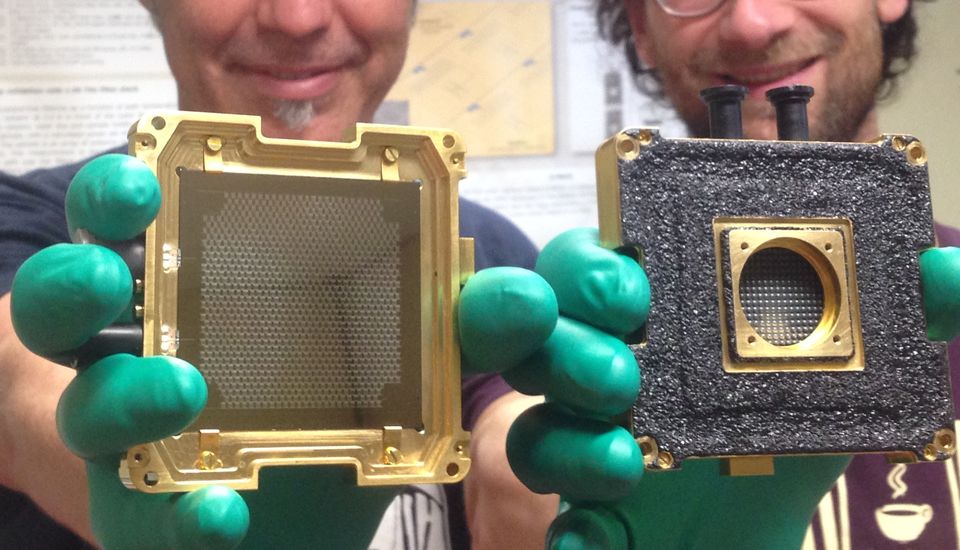27 JUNE 2017
Researchers from various institutions, including SRON and Delft University of Technology, have demonstrated that it is possible to make a highly sensitive space camera for far-infrared astronomy by using a special type of superconducting detector. Using 961 KID detectors they built a chip for such a camera, which satisfies astronomers’ strict requirements for reliability and sensitivity. Furthermore, the camera system is also made resistant to certain equipment-threatening circumstances in space like cosmic radiation.
Astronomers worldwide are eagerly looking forward to a space telescope that has a sensitive far-infrared camera containing many pixels. About half of all the energy from the universe reaches us via this radiation (wavelengths of 0.03 to 1 millimeters, the Terahertz frequency range). Measuring this radiation allows us to make far more accurate observations of the very cool and distant parts of the universe. Such a space telescope is needed because the earth's atmosphere hinders our infrared view of space.
KIDS in space
The Kinetic Induction Detector (KID) is extremely sensitive for far infrared light. Furthermore, with KIDs it is relatively to simple mount and read out many pixels on a single chip. For several years now, KIDs have been used in ground telescopes with excellent results. However, the effective use of KIDs in a space telescope had not previously been demonstrated. The researchers had to overcome several extra challenges to make this possible.
The KID is so hypersensitive due to certain superconducting properties, which only occur at extremely low temperatures. The researchers therefore made a test environment in Utrecht with a temperature at almost absolute zero (100 mK) in which such camera system could be tested. Another challenge was the jump in sensitivity the camera had to make compared to its predecessors. The camera had to be a factor of 100 times more sensitive than similar cameras on Earth before the international community would be willing to build and launch a special space telescope for this. This means an array of about 1000 pixels.
Practical obstacles
The researchers of the '1000 pixel camera' also had to overcome various practical obstacles. For example, the pixels can influence each other (crosstalk) if they are situated too close together in a single array. And all the signals have to be read out and amplified: using numerous wires to achieve this could give rise to unwanted heat in the vicinity of the detector. The researchers solved that problem using a technique that reads out almost 1000 pixels via a single pair of wires (multiplexing). The necessary electronics for this were developed during this project by SRON in collaboration with the company AimValley from Hilversum. The lens arrays required were produced in collaboration with Veldlaser from ‘s-Heerenberg.
Crucial measurements such as resilience against cosmic radiation, crosstalk, the precise readout accuracy of the separate pixels via multiplexing, and the percentage of pixels that performed well, yielded fantastic results. The KID array system is now mature enough to be used in a proposed far-infrared mission comparable with the Japanese-European SPICA telescope or the American Origins Space Telescope.

International consortium
For this step to space-proof KID systems, SRON and Delft University of Technology collaborated in an international consortium of research groups (project SPACEKIDs). The development of the camera described by SRON researcher Jochem Baselmans and his fellow researchers was one of the most important results. They recently published the results in the renowned journal Astronomy & Astrophysics.
The feasibility of using KIDs in a 1000-pixel camera has been demonstrated with KIDs for 0.9 THz. Researchers from SRON and Delft University of Technology are well on their way towards achieving the next step: developing a KID with an antenna for in an array above 1.0 THz, a wavelength range that contains a lot of astronomical information. Researcher Juan Bueno from SRON and his fellow researchers have now developed pixels for a KID array that can measure all frequencies between 1.4 and 2.8 Terahertz. This had not previously been demonstrated. Bueno and his colleagues published these results start of June in Applied Physics Letters.















